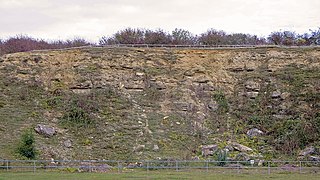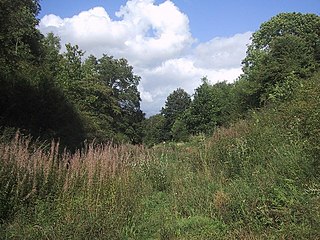
Megalosaurus is an extinct genus of large carnivorous theropod dinosaurs of the Middle Jurassic period of southern England. Although fossils from other areas have been assigned to the genus, the only certain remains of Megalosaurus come from Oxfordshire and date to the late Middle Jurassic.

Magnosaurus was a genus of theropod dinosaur from the Middle Jurassic of England. It is based on fragmentary remains and has often been confused with or included in Megalosaurus.
Chuandongocoelurus is a genus of carnivorous tetanuran theropod dinosaur from the Jurassic of China.
The Twin Mountains Formation, also known as the Twin Mak Formation, is a sedimentary rock formation, within the Trinity Group, found in Texas of the United States of America. It is a terrestrial formation of Aptian age, and is notable for its dinosaur fossils. Dinosaurs from this formation include the large theropod Acrocanthosaurus, the sauropod Sauroposeidon, as well as the ornithopods Tenontosaurus and Convolosaurus. It is the lowermost unit of the lower Cretaceous, lying unconformably on Carboniferous strata. It is overlain by the Glen Rose Formation. It is the lateral equivalent of the lower part of the Antlers Formation.

Duriavenator is a genus of theropod dinosaur that lived in what is now England during the Middle Jurassic, about 168 million years ago. In 1882, upper and lower jaw bones of a dinosaur were collected near Sherborne in Dorset, and Richard Owen considered the fossils to belong to the species Megalosaurus bucklandii, the first named non-bird dinosaur. By 1964, the specimen was recognised as belonging to a different species, and in 1974 it was described as a new species of Megalosaurus, M. hesperis; the specific name means 'the West' or 'western'. Later researchers questioned whether the species belonged to Megalosaurus, in which many fragmentary theropods from around the world had historically been placed. After examining the taxonomic issues surrounding Megalosaurus, Roger B. J. Benson moved M. hesperis to its own genus in 2008, Duriavenator; this name means "Dorset hunter".
The Taynton Limestone is a geological formation in Oxfordshire in the United Kingdom. It dates to the Middle Jurassic, mid-Bathonian stage. It predominantly consists of ooidal grainstone. The term "Stonesfield Slate" refers to slaty limestone horizons within the formation that during the 18th and 19th centuries were extensively quarried for use in roof tiling within the vicinity of Stonesfield, Oxfordshire. Previously these were thought to belong to the Sharp's Hill Formation, but boreholes and shaft sections suggest that at least three horizons within the Taynton Limestone were quarried for the slate. These horizons are well known for producing a diverse set of fossils including those of plants, insects as well as vertebrates, including some of the earliest known mammals, pterosaurs as well as those of first dinosaur ever described, Megalosaurus.

The Inferior Oolite is a sequence of Jurassic age sedimentary rocks in Europe. It was deposited during the Middle Jurassic. The Inferior Oolite Group as more recently defined is a Jurassic lithostratigraphic group in southern and eastern England. It has been variously known in the past as the Under Oolite, the Inferior Oolite, the Inferior Oolite Series and the Redbourne Group.

The Forest Marble is a geological formation in England. Part of the Great Oolite Group, it dates to the late Bathonian stage of the Middle Jurassic.

The Paluxy Formation is a geological formation found in Texas, Louisiana, Arkansas, Mississippi and Oklahoma, whose strata date back to the Early Cretaceous. Dinosaur remains are among the fossils that have been recovered from the formation.
The Montejunto Formation is an Oxfordian geologic formation in Portugal. Dinosaur remains diagnostic to the genus level are among the fossils that have been recovered from the formation.
The Cerro Castillo Formation is a Jurassic geologic formation in Argentina. Dinosaur remains diagnostic to the genus level are among the fossils that have been recovered from the formation.
The Caranguejeira Conglomerate is an Aptian to Cenomanian geologic formation in Portugal. Dinosaur remains diagnostic to the genus level are among the fossils that have been recovered from the formation.
The Great Oolite Group is a Middle Jurassic stratigraphic unit that outcrops in southern England. It consists of a complex set of marine deposits primarily mudstone and bioclastic ooidal and fine grained limestone, deposited in nearshore to shelf settings. It is exposed at the surface as a variably thick belt extending roughly NE-SW from the coast of Dorset up to the Humber. It is also present at depth in the Weald and Wessex Basins, as well as offshore. Several of the constituent formations, notably the Taynton Limestone Formation and the Forest Marble Formation are notable for their fossil content, including those of dinosaurs and pterosaurs and some of the earliest mammals.
The Hampen Formation is a Jurassic geological formation of Bathonian age found in central Southern England. Dinosaur remains diagnostic to the genus level are among the fossils that have been recovered from the formation. This formation was formerly known as the Hamden Marly Formation or the Hamden Marly Beds.
The Marshalltown Formation is a Mesozoic geologic formation. Dinosaur remains diagnostic to the genus level are among the fossils that have been recovered from the formation.
The Vega Formation is a Late Jurassic (Kimmeridgian) geologic formation of the Ribadesella Group in Asturias, Spain. Dinosaur remains diagnostic to the genus level are among the fossils that have been recovered from the formation. The formation is around 150 metres thick and consists of "alternating white, pale grey and reddish sandstones, and red mudstones with several sporadic conglomeratic beds typically arranged in minor finnig-upward cycles within a major cycle of the same character". An isolated caudal theropod vertebra and a partial tooth are known from the formation, belonging to large megalosaurids around 10 metres in length, comparable to Torvosaurus. Other remains known from the formation include fragmentary turtle remains, crocodylomorph teeth, as well as a sauropod caudal vertebra (MUJA-0650). Dinosaur tracks are also known from the formation, including large theropod footprints and poorly preserved quadrupedal dinosaur footprints.

The White Limestone Formation is a Bathonian geologic formation in the United Kingdom, dating to the Middle Jurassic, 168.3 to 166.1 million years ago. Fossil sauropod tracks have been reported from the formation. It is the lateral equivalent of the Blisworth Limestone. It predominantly consists of grey-yellow limestone, typically wackestone and packstone with subordinate ooidal grainstone. The Woodeaton Quarry locality has yielded microvertebrates.
The Black Creek Group is a geologic group in North Carolina. It preserves fossils dating back to the Late Cretaceous period.
The Rutland Formation is a geologic formation in England. It preserves fossils dating back to the late Bajocian to Bathonian stages in the Jurassic period, about 169 million years ago. It is the lateral equivalent of the Sharp's Hill Formation and the Fuller's Earth Formation. The "Rutland Dinosaur" specimen of Cetiosaurus is known from the formation.

The Chipping Norton Limestone is a geological formation in the Cotswolds, England. It preserves fossils dating back to the Bathonian. Including those of dinosaurs Cetiosaurus, Megalosaurus and Cruxicheiros as well as the Tritylodontid Stereognathus. It primarily consists of ooidal limestone.








